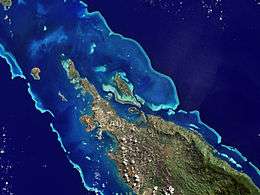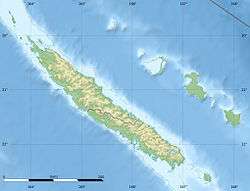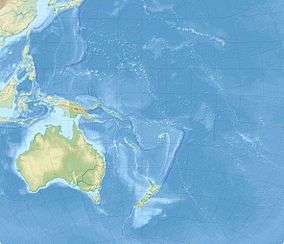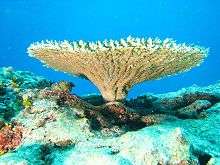New Caledonian barrier reef
| UNESCO World Heritage site | |
|---|---|
 Northern tip of Grande Terre | |
| Location | New Caledonia (state party: France) |
| Includes |
|
| Criteria | Natural: (vii), (ix), (x) |
| Reference | 1115 |
| Inscription | 2008 (32nd Session) |
| Area | 1,574,300 ha (3,890,000 acres) |
| Buffer zone | 1,287,100 ha (3,180,000 acres) |
| Coordinates | 20°24′43″S 164°33′59″E / 20.41194°S 164.56639°ECoordinates: 20°24′43″S 164°33′59″E / 20.41194°S 164.56639°E |
 Location of New Caledonian barrier reef in New Caledonia  New Caledonian barrier reef (Oceania) | |
The New Caledonian barrier reef is located in New Caledonia in the South Pacific, and is the longest continuous barrrier reef in the world and the second largest after the Great Barrier Reef of Australia.
The New Caledonian barrier reef surrounds Grande Terre, New Caledonia's largest island, as well as the Ile des Pins and several smaller islands, reaching a length of 1,500 kilometres (930 mi). The reef encloses a lagoon of 24,000 square kilometres (9,300 sq mi), which has an average depth of 25 metres (82 ft). The reefs lie up to 30 kilometres (19 mi) from the shore, but extend almost 200 kilometres (120 mi) to the Entrecasteaux reefs in the northwest. This northwestern extension encloses the Belep Islands and other sand cays. Several natural passages open out to the ocean. The Boulari passage, which leads to Noumea, the capital and chief port of New Caledonia, is marked by the Amédée lighthouse.
Ecology
The reef systems of New Caledonia are considered to be the second largest in the world after the Great Barrier Reef of Australia, the longest continuous barrier reef in the world with a length of 1.600 km and its lagoon, the largest in the world with an area of 24.000 square kilometers. This ecosystem hosts along with Fiji, the world’s most diverse concentration of reef structures, 146 types based on a global classification system, and they equal or even surpass the much larger Great Barrier Reef in coral and fish diversity.
The reef has great species diversity with a high level of endemism, and is home to endangered dugongs (Dugong dugon) with the third largest population, and is an important nesting site for green sea turtle (Chelonia mydas).[1] In the lagoons of New Caledonia there are many water species ranging from plankton to larger fish and even sharks.
Environmental Threats
Most of the reefs are generally thought to be in good health. Some of the eastern reefs have been damaged by effluent from nickel mining on Grand Terre. Sedimentation from mining, agriculture, and grazing has affected reefs near river mouths, which has been worsened by the destruction of mangrove forests, which help to retain sediment. Some reefs have been buried under several metres of silt.[2]
In January 2002, the French government proposed listing New Caledonia's reefs as a UNESCO World Heritage Site. UNESCO listed New Caledonia barrier beef on the World Heritage List under the name The Lagoons of New Caledonia: Reef Diversity and Associated Ecosystems on 7 July 2008.[3] The Lagoons were listed under three UNESCO categories:
- Superlative natural Phenomena or natural beauty
- Ongoing Biological and ecological processes
- Biological Diversity and threatened species
There are 13 local management committees, composed of tourist operators, fishermen, politicians and chiefs of local tribes which work with the community to monitor the health of the lagoons.[4]
Human Use
Scuba Diving is common, with several dive sites in the lagoon and around the reef. These include the Prony needle, the Shark Pit and the Cathedral.[5]

 ASTER image of the lagoons
ASTER image of the lagoons
See also
External links
| Wikimedia Commons has media related to New Caledonian lagoon. |
References
- ↑ "Lagoons of New Caledonia: Reef Diversity and Associated Ecosystems". UNESCO. Retrieved 18 December 2016.
- ↑ "New Caledonia Barrier Reef". WWF. Retrieved 18 December 2016.
- ↑ "Lagoons of New Caledonia: Reef Diversity and Associated Ecosystems". UNESCO. Retrieved 18 December 2016.
- ↑ "Historic Local community meeting in New Caledonia to strengthen World Heritage conservation". UNESCO. 20 July 2015. Retrieved 18 December 2016.
- ↑ "Scuba Diving". nouvelle caledonie. Retrieved 18 December 2016.
